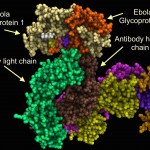viruses
The 2013-2016 West African Ebola virus outbreak altered our perception of just what an Ebola outbreak could look like.
While none of the three primary affected countries--Liberia, Sierra Leone, and Guinea-have had a case since April 2016, the outbreak resulted in a total of over 28,000 cases of Ebola virus disease (EVD)--65 times higher than the previous largest EVD outbreak, and more than 15 times the total number of cases of all prior EVD outbreaks combined, from the virus's discovery in 1976 to a concurrent (but unrelated) outbreak in the Democratic Republic of Congo in 2014.
In March 2016…
It's well understood in science education that students are more engaged when they work on problems that matter. Right now, Zika virus matters. Zika is a very scary problem that matters a great deal to anyone who might want to start a family and greatly concerns my students.
I teach a bioinformatics course where students use computational tools to research biology. Since my students are learning how to use tools that can be applied to this problem, I decided to have them apply their new bioinformatics skills to identify drugs that work against Zika…
As you've probably seen, unless you've been living in a cave, Zika virus is the infectious disease topic du jour. From an obscure virus to the newest scare, interest in the virus has skyrocketed just in the past few weeks:
I have a few pieces already on Zika, so I won't repeat myself here. The first is an introductory primer to the virus, answering the basic questions--what is it, where did it come from, what are its symptoms, why is it concerning? The second focuses on Zika's potential risk to pregnant women, and what is currently being advised for them.
I want to be clear,…
When my parents were young, summer made cities a scary place for young families. My mother tells me children were often sent away from their homes to relatives in the country, if possible, and swimming pools were definitely off limits. The disease they feared, poliomyelitis, and the havoc it wrecked were the stuff of nightmares. Children could wake up with a headache and end up a few hours later, in an iron lung, struggling to breathe.
Poliovirus colored by molecule in Molecule World.
…
As an unprecedented outbreak of Ebola crosses borders in West Africa, people are asking new questions about the virus and its potential to turn into a global pandemic (hint: it's not gonna happen). Greg Laden writes "The disease is too hot to not burn itself out, and it has no human reservoir. Ebola accidentally broke into the human population earlier this year or late last year." The current numbers from the WHO suggest 1800 confirmed and suspected cases of Ebola so far with a mortality rate edging down toward 55%.
Last week some in the U.S. objected to bringing two American patients…
In 1925, dogsledders raced through the frozen Alaskan bush to bring antiserum to the isolated village of Nome. The antiserum arrived in time, saved the lives of many villagers from the horrors of diphtheria, and inspired the Iditarod, a famous race in celebration of the dog sledders' heroic feat.
West Africa could use a similar effort today. Richard Harris's blog at NPR has a good story about doctors' efforts to develop and use antiserum to treat Ebola. According to ABC news, Dr. Kent Brantly, who is being seen at Emory University Hospital was treated…
On Aetiology, Tara C. Smith continues her series on the science of The Walking Dead, explaining how diseases spread and how they might cause zombiism. One thing that would be observed in any real contagion would be an incubation period— the time between when a virus (for example) enters your body and you start showing symptoms of infection. For a virus like the flu, this could be about two days during which you don’t feel sick but could still be infecting people around you—even if you don’t bite them. Tara also expresses nerd rage at the show's "doctors" pursuing antibiotics to…
Third of five student guest posts by Dana Lowry
In 1911, Peyton Rous first discovered viruses can cause cancer. A chicken with a lump in her breast had been brought to Rous by a farmer. Rous prepared an extract that eliminated bacteria and tumor cells and injected this extract into other chickens—tumors grew. Rous suggested “a minute parasitic organism” was causing the tumor growth, which is now known to be a virus. However, Rous’ discovery remained very controversial, and it wasn’t until 1966 that he was awarded a Nobel Prize for his discovery. Since…
Flu season is gearing up in the northern hemisphere, and this year's strains appear more virulent than usual. In the United States, the Centers for Disease Control declared an epidemic on January 11; the CDC estimates that between 3,000 and 49,000 people die from influenza or its complications every year. By comparison, the infamous flu of 1918 may have killed 500,000 Americans. Although the very young, elderly, and diseased bear the highest risk of death, healthy adults still bear the responsibility of minimizing overall transmission of the virus. In other words,…
There are a lot of reasons that posts to this blog sometimes don't happen for months at a time, but one of them is that I can often get sucked down the rabbit hole that is Reddit. If you don't know about reddit yet, you may not want to click that link, but if you do know (and you're reading this blog), you may know about one of the communities (subreddits) there - a place called r/askscience. It's a forum where people can ask questions of a scientific nature (anything from "Why are pigeons so successful as an urban animal?" to "What's so special about the speed of light?"), and then actual…
I discuss the topic of emerging infectious diseases today over at Slate, as part of their Pandemic series.
Uganda's latest Ebola outbreak, which I covered back in July, was just officially declared over on October 5th, a mere two weeks ago. Now today there is a report that three are dead from an outbreak of Marburg virus. That makes 4 Ebola outbreaks and now 2 Marburg outbreaks in the country since 2000.
In Uganda, the fourth outbreak of Ebola in twelve years has killed sixteen people. On We Beasties, Kevin Bonham says the virus is "readily transmissible," kills quickly and assuredly, "and the way it kills is gruesome - causing massive bleeding from all orifices." These may seem like dominant characteristics, but a virus is not a predator. Bonham says Ebola viruses, like other emerging diseases, are "poorly adapted for our immune systems," and wipe out their hosts too quickly to spread. But all that can, of course, change. On Aetiology, Tara C. Smith details the history of outbreaks in Uganda…
Uganda just can't catch a break. They've recently been hit with nodding disease, a mysterious syndrome where children repeatedly nod their heads and undergo serious seizures, typically leading to death. Now they're in the grips of another Ebola outbreak. This will be the fourth time the country has suffered through Ebola since 2000, when the virus was first found in the country:
The first occurred in August of 2000; the first case died in Gulu on the 17th of September. Despite an investigation, doctors were unable to determine where or how she had contracted the disease. Her death was…
On ERV, Abbie Smith writes “Malaria kills 1.24 million people a year. Mostly babies under 5 years old.” Malaria, although carried by mosquitoes, is caused by a single-celled protist which infects the liver and goes on to parasitize red blood cells. Now, a little genetic engineering could put a stop to this scourge. Smith says “Mosquitoes have a symbiotic relationship with their bacteria the same way we do—they need their ‘good’ bacteria to get all the nutrients they need to survive.” By tweaking the protein output of one such bacteria, scientists have made mosquito guts inhospitable to…
With my colleague Greg Tinkler, I spent an afternoon last week at a local public library talking to kids about zombies:
The Zombie Apocalypse is coming. Will you be ready? University of Iowa epidemiologist Dr. Tara Smith will talk about how a zombie virus might spread and how you can prepare. Get a list of emergency supplies to go home and build your own zombie kit, just in case. Find out what to do when the zombies come from neuroscientist Dr. Greg Tinkler. As a last resort, if you can't beat them, join them. Disguise yourself as a zombie and chow down on brrraaaaiiins, then go home and…
This is the fifteenth of 16 student posts, guest-authored by Cassie Klostermann.
One of the major accomplishments that public health professionals pride themselves in is the reduction of people getting sick or dying from preventable infectious diseases. Unfortunately, these debilitating, historic diseases that health professionals had once thought they had under control are starting to rear their ugly heads once again in the United States (U.S.). One of these diseases that I am referring to is measles. Measles is a highly contagious virus (from the genus Morbillivirus) spread…
On ERV, Abbie Smith reports that scientists have discovered an entirely new branch of viruses in the boiling acid pools of Yellowstone National Park. By analyzing RNA segments from the pools, researchers inferred the existence of positive-strand RNA viruses with unknown genetic configurations. Smith writes, “These viruses are not just kinda new. They are really really different from the RNA viruses we already know about!” They infect primordial single-celled organisms called Archaea which thrive in the extreme heat of the pools. On the multicellular side of life…
We've all heard of bird and swine flu, but bats, which comprise "about a fifth of all known mammalian species," also carry a diverse host of viruses. By swabbing the rectums of little yellow-shouldered bats, researchers in Guatemala discovered a new influenza virus that defies easy classification. Flu viruses are described by two key genes—hence the name 'H1N1.' Tara C. Smith writes "The novel bat virus was a completely new H type—type 17 (provisional, they note, pending further analyses). The NA gene was also highly divergent." Smith continues "the authors did do some molecular work…
I mentioned last month that we are planning an Emerging Diseases conference here in April. Things are moving quickly and registration is now open (here). Abstract submission is also up and running here.
The details:
Oral and poster presentation research abstracts are due by 5:00pm on March 23, 2012. Individuals may submit up to two research abstracts. Abstracts must not exceed 250 words in length. There are a limited number of spots available for those interested in providing a 15-minute oral presentation. Abstracts submitted for oral presentations that are not selected for a talk will…





